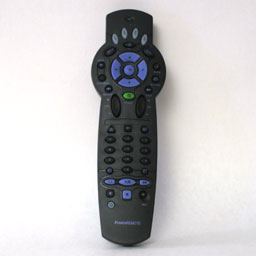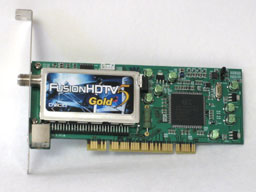HTPC - TV Tuner Reviews
by Jarred Walton on December 7, 2005 12:05 AM EST- Posted in
- Smartphones
- Mobile
DVICO Fusion5 Gold
The Fusion5 Gold is the top-end product from DVICO. Having never used any of their other cards, we can't really say how it compares to previous models. We started with the latest software version at the time of testing, FusionHDTV version 3.11. As Murphy would have expected, a new beta version 3.19.05 is now available, so we've retested the card. (Don't worry about the software being "beta" as opposed to an official release; version 3.11 and all the preceding versions are just as "beta" in our opinion.) Updated software has been made available on a pretty regular basis (every month or two), and we would venture to say that earlier versions of the software had quite a few bugs. (Forum posts around the web will quickly show this to be the case.) 3.11 definitely has some problems, but 3.19 seems to have finally addressed the majority of our concerns.
The card itself is notable for several reasons. First, it is a half-height card. Putting this into any PCI slot should present no problem, but DVICO actually went the extra mile and included a half-height mounting bracket if you want to use it in a slim form factor case. That's a great decision on their part, and it makes this the only card of the three that could be used in something like the Aopen MZ855-II or quite a few OEM PC systems. (The tuner on the card does get quite hot, though, so perhaps it wouldn't be a good idea to put it in such a small case.)
The smaller design does have some drawbacks, unfortunately. For one, the card only has a single antenna input, with an S-VIDEO port that can also be used with a Composite dongle. The card also depends on software to do a portion of the work, helped by a Connexant CX23882 chip as well as additional chips inside the LG "tuner box". The decoding of the digital channels is done in software, but FusionHDTV supports DxVA graphics cards, which can be used to offload a decent amount of the work with most recent ATI and NVIDIA chips.
Besides the card, there are a couple of other pieces of hardware. A remote is included, along with a USB receiver with which the remote communicates. While the remote is fully functional, we can't say that it's very elegant. This is the largest remote of any of the products, and it's also the ugliest remote. If that matters to you, look elsewhere, but we really can't say that it's a deal breaker. You'll also want to be careful not to press the wrong power button (the one in the lower left corner of the remote), as you can accidentally shut down/suspend the PC rather than just turning off the software interface.
There is a Fusion5 Lite card available, with the primary difference being support for additional encoding options with the Gold version and some additional software. You can see the comparison sheet at the bottom of the DVICO specifications page. The Lite model also omits the remote, which adds another $20-$40 if purchased separately. For the extra $30, it's probably worthwhile to simply go with the Gold card, unless you're sure that you don't want the extras. The remote isn't technically necessary, especially if you have a wireless mouse with a decent reception range.
The Fusion5 Gold is the top-end product from DVICO. Having never used any of their other cards, we can't really say how it compares to previous models. We started with the latest software version at the time of testing, FusionHDTV version 3.11. As Murphy would have expected, a new beta version 3.19.05 is now available, so we've retested the card. (Don't worry about the software being "beta" as opposed to an official release; version 3.11 and all the preceding versions are just as "beta" in our opinion.) Updated software has been made available on a pretty regular basis (every month or two), and we would venture to say that earlier versions of the software had quite a few bugs. (Forum posts around the web will quickly show this to be the case.) 3.11 definitely has some problems, but 3.19 seems to have finally addressed the majority of our concerns.
The card itself is notable for several reasons. First, it is a half-height card. Putting this into any PCI slot should present no problem, but DVICO actually went the extra mile and included a half-height mounting bracket if you want to use it in a slim form factor case. That's a great decision on their part, and it makes this the only card of the three that could be used in something like the Aopen MZ855-II or quite a few OEM PC systems. (The tuner on the card does get quite hot, though, so perhaps it wouldn't be a good idea to put it in such a small case.)
The smaller design does have some drawbacks, unfortunately. For one, the card only has a single antenna input, with an S-VIDEO port that can also be used with a Composite dongle. The card also depends on software to do a portion of the work, helped by a Connexant CX23882 chip as well as additional chips inside the LG "tuner box". The decoding of the digital channels is done in software, but FusionHDTV supports DxVA graphics cards, which can be used to offload a decent amount of the work with most recent ATI and NVIDIA chips.
 |
 |
| Click to enlarge. | |
Besides the card, there are a couple of other pieces of hardware. A remote is included, along with a USB receiver with which the remote communicates. While the remote is fully functional, we can't say that it's very elegant. This is the largest remote of any of the products, and it's also the ugliest remote. If that matters to you, look elsewhere, but we really can't say that it's a deal breaker. You'll also want to be careful not to press the wrong power button (the one in the lower left corner of the remote), as you can accidentally shut down/suspend the PC rather than just turning off the software interface.
There is a Fusion5 Lite card available, with the primary difference being support for additional encoding options with the Gold version and some additional software. You can see the comparison sheet at the bottom of the DVICO specifications page. The Lite model also omits the remote, which adds another $20-$40 if purchased separately. For the extra $30, it's probably worthwhile to simply go with the Gold card, unless you're sure that you don't want the extras. The remote isn't technically necessary, especially if you have a wireless mouse with a decent reception range.











77 Comments
View All Comments
JarredWalton - Thursday, December 8, 2005 - link
Just to clarify, I'm speaking of overlay mode in general. The MyHD card overlay mode is limited to 720 x 484 reason. It does hardware decoding, which means it's generating the uncompressed HDTV stream on the card. A 720P compressed signal is up to 15 Mb per second. That presents no problem for the PCI bus. Uncompressed 720P, on the other hand, requires more bandwidth than the PCI bus can handle.1280 x 720 = 921600 pixels per frame
4 bytes per pixel = 3686400 bytes per frame.
60 frames per second = 221184000 bytes per second.
The PCI bus is a 32-bit bus, running at 33 MHz, giving a maximum bandwidth of 133 MB per second. Uncompressed 720P would require about 211 MB per second. This is one of many reasons that the AGP slot was created. The CPU can render into an AGP cards memory at up to 2133 MB per second, at least in theory.
So there is a reason that the my HD card doesn't render the overlay mode in anything more than 720 x 480. That doesn't mean I have to like that limitation. :-)
Crucial - Wednesday, December 7, 2005 - link
I don't understand what the point of this review was. Why would you test a hardware based analog card with 2 cards that have software based analog? The addition of the theatre 550 card was completely unecessary and frankly makes no sense at all.A more effective test would have put the 2 HD cards up against the ATI HDTV wonder and another seperate test putting the 550 against the Hauppage pvr150 and an Avermedia card.
The Boston Dangler - Wednesday, December 7, 2005 - link
Good oneJarredWalton - Wednesday, December 7, 2005 - link
The review was because I had the cards. We've had complaints about putting out single item reviews. We've already looked at the HDTV Wonder, and it doesn't work for me - no QAM support and I don't want to get an expensive OTA antenna for a rental home. The whole article is a "state of the TV Tuner market" as well as individual card reviews, or at least that's how I intended it. Besides, the Theater 550 PCIe is really just a PCIe version of the PCI card we've already looked at, which is good to know.Previous analog tuners have been reviewed, and the ATI HDTV Wonder has also been reviewed. If you can get good OTA DTV reception, you probably have no need for something like the Fusion5 or MyHD. For people like me, though, the choices boil down to forgetting about DTV, getting a DVR upgrade to my cable box, and/or getting one of those two cards.
After playing with all the cards, I would say your best bet for quality is to get two cards, one of analog and a second for DTV.
Ceramicsteve - Wednesday, December 7, 2005 - link
Hey can you include a Mac based HDTV tuner in your round up? The only one I know of is EyETV from Elgato systems and it comes in a form of a breakout box.scott967 - Wednesday, December 7, 2005 - link
I take it none of these tuners support HDCP on the digital out?scott s.
.
JarredWalton - Wednesday, December 7, 2005 - link
That's correct, though I may have screwed up when I talked about my TV. I don't know if it has an HDMI or an HDCP port. I thought it was HDMI, but I could be mistaken.Olaf van der Spek - Wednesday, December 7, 2005 - link
> Using the Sempron 64 running at 2.50 GHz was more than sufficient for everything but the MyHD analog recording.There are no Semprons that run at 2.5 ghz.
JarredWalton - Wednesday, December 7, 2005 - link
I had it overclocked -- I was trying to see if I could get it to work OK for the MyHD card.Olaf van der Spek - Thursday, December 8, 2005 - link
It may be a good idea to mentioned you were overclocking.